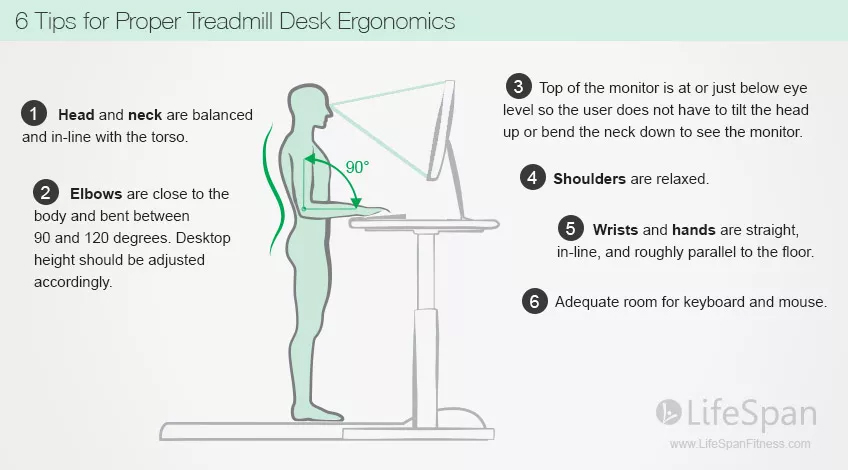 Loading... Please wait...
Loading... Please wait...
Setting Up Your Treadmill Desk or Standing Desk With Proper Ergonomics
- Home
- Setting Up Your Treadmill Desk or Standing Desk With Proper Ergonomics
What is Ergonomics?
First, what do we mean by ergonomics? Ergonomics is the applied science of equipment design, as for the workplace, intended to maximize productivity by reducing operator fatigue and discomfort. Therefore, when using a treadmill desk or standing desk, always remember the goals of avoiding unnecessary strain on the joints and decreasing the potential of fatigue.
Ergonomic Tips
There are basic ergonomic tips to consider when setting up your treadmill desk or standing desk. Remember the concept of neutral body positioning and follow these recommendations:

- Head and neck are balanced and in-line with the torso.
- Elbows are close to the body and bent between 90 and 120 degrees. Desktop height should be adjusted accordingly.
- Top of the monitor is at or just below eye level so the user does not have to tilt the head up or bend the neck down to see the monitor.
- Shoulders are relaxed.
- Wrists and hands are straight, in-line, and roughly parallel to the floor.
- Adequate room for keyboard and mouse.
According to the Occupational Health and Safety Administration, United States Department of Labor, when determining the best way to set up a treadmill desk, it is helpful to understand the concept of neutral body positioning, i.e., a comfortable working posture in which the joints align naturally. Working with the body in a neutral position reduces stress and strain on the muscles, tendons, skeletal system, and reduces the risk of developing a musculoskeletal disorder. In the standing position, posture should be such that the legs, torso, neck, and head are approximately in-line and vertical.
A number of writers chronicle their use of treadmill desks, e.g. the Treadmill Desk Diary, and their tips can be useful. However, it is important to remember that you must find the acceptable position and product that enhances you work environment and provides the greatest health benefit. With that in mind, there are organizations and companies beginning to realize the importance of sitting less, standing and moving more, and are implementing strategies to assist employees to do so. Emory University is an example and offers Individualized Workstation Evaluations to educate, evaluate, and plan for a more productive and user-friendly desk.
When purchasing a treadmill desk, investigate products to fit the needs of the office environment. Based on proper ergonomics ask questions about the desk and the treadmill.
- Is the desktop height adjustable?
- Does the desktop height adjust manually or electrically?
- How large is the desktop?
- Will I have enough room for the keyboard and mouse?
- Can I add-on a desktop display mount?
